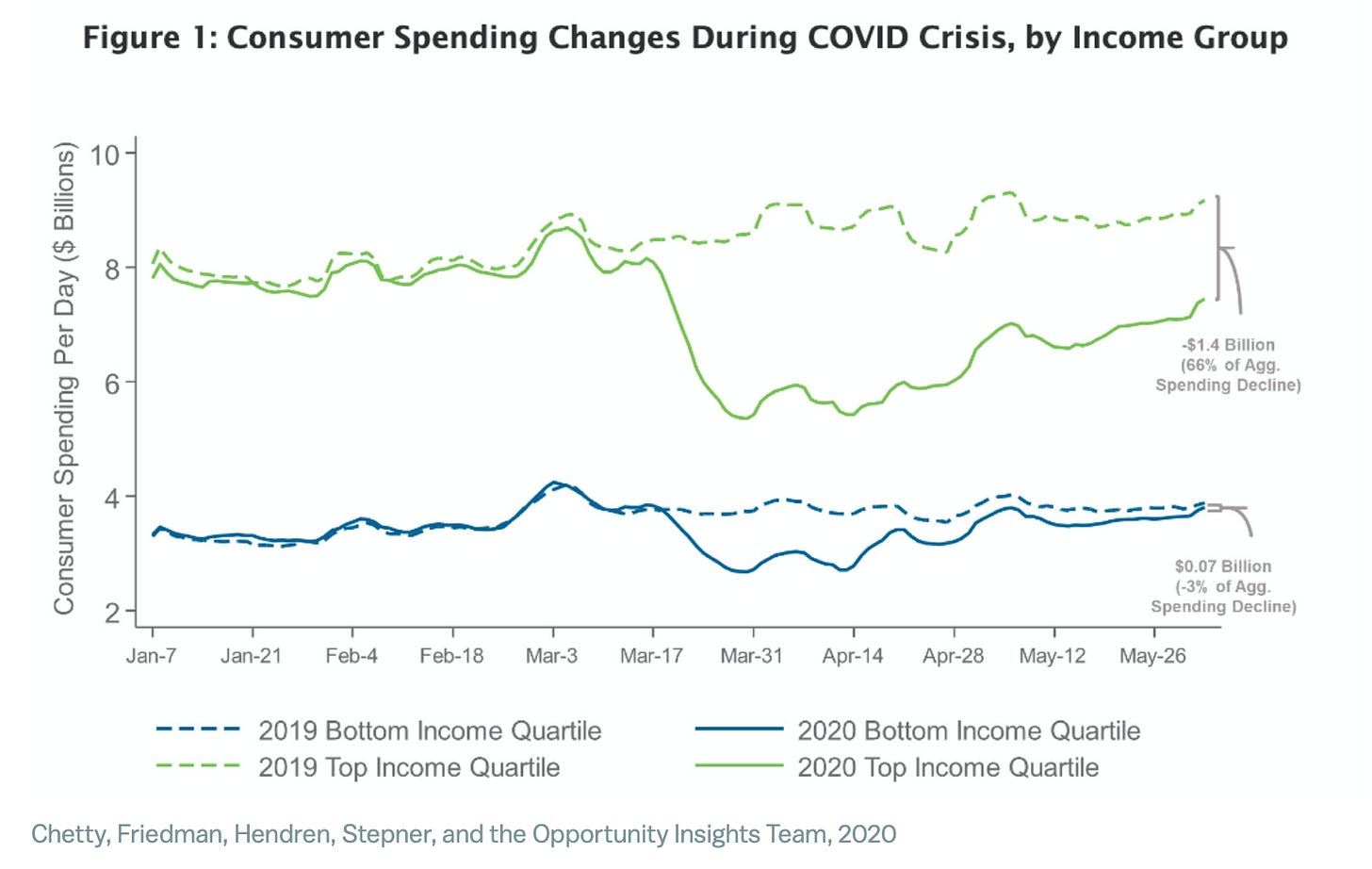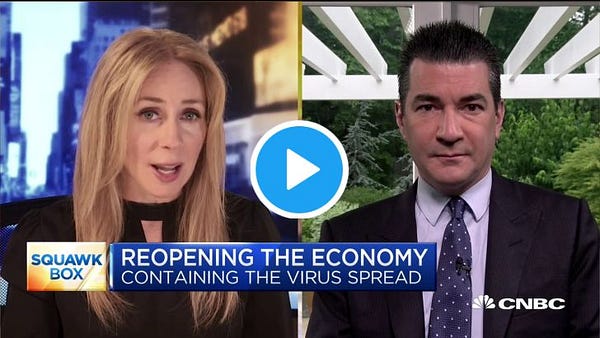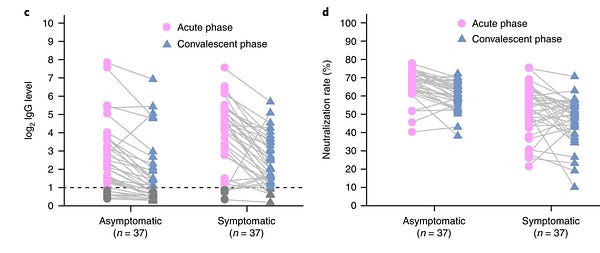🦠 COVID-19 | Out of control?
📊 Daily Data Brief: June 19, 2020, 07:19 GMT (❗️Previous data: June 17, 2020, 06:03 GMT)
Cumulative case: 8,586,718 (+321,544) cumulative cases
Active cases: 3,594,204 (+97,837) (this is the number of currently infected patients)
Total Deaths: 456,468 (+10,319)
Serious/Critical Cases: 54,566 (-26)
Recovered: 4,536,046 (+223,388)
Source: Worldometers
1) Seven-day rolling average of new deaths (ECDC data).

Showing a chart from the FT today highlighting the worrying situation in Brazil, Mexico, India and Russia and Iran (NEW❗️). Also the FT comparative charts now allow up to 6 countries.

2) Rt estimate per State (US) and per country (NEW❗️). This is a new resource link in the data section from a team which has led accuracy in modelling fatalities in the US for the past few weeks. (Link)

A great article showing that you do not reopen the economy by simply changing your lockdown policy, but rather by convincingly addressing the public health concerns stemming from the level of circulation of SARS-CoV-2 in your region.
Somewhat not heeding the findings from the paper above, the US seems content to live with high level of case numbers as Scott Gottlieb outlines in his video of the day. As he points out, there are not guarantee that it will not get out of control. An update on the situation in Beijing with an article from the Financial Times as.
The Reuters Institute for the Study of Journalism puts out the 5th chapter of its survey on trust in government and news. Contact tracing apps do not fare well.
On the science side, an important paper studying asymptomatic patients and a review article on the state of research on children and COVID-19.
On the policy side, the roadblocks which contact tracers are facing in the US, unfortunately expose the frailty of its society: spammy marketing calls, distrust in government and weak paid-sick leave regimes. Finally, a warning article about a potential summer lull in the epidemic not necessarily being a cause for celebration.
🛑 Article of the day: Dylan Matthews writes “A new paper finds stimulus checks, small business aid, and “reopening” can’t rescue the economy” for Vox. (Link)
Matthews reports on a research paper by Raj Chetty et al. titled “How Did COVID-19 and Stabilization Policies Affect Spending and Employment? A New Real-Time Economic Tracker Based on Private Sector Data.” and its associated data tracker. It is both a sobering and insightful paper.
The first part of the article goes into describing the tracker, its relevance and accuracy on existing data input and how Chetty and his team plan to expand data sources to provide even more insights to policy makers.
The rest of the article goes into some details in the 5 key findings in the paper:
1) “The high-income recession”: it is consumer spending amongst the ‘top income quartile” which has been hit the most and in particular serviced businesses with “in-person physical interaction”

2) “Those who serve the rich are suffering most”
3) “Stimulus checks kept people afloat, but not small businesses”
4) “Paycheck Protection didn’t do much” for small businesses but “excelled” at getting their workers through this calamity.
5) “Reopening orders don’t actually reopen the economy”: this echoes what Bill Gates had said early on in the crisis. Until you get a treatment that is 95% effective against COVID-19, life (and the economy) will not return to normal. The government cannot restore confidence just by “reopening”:
“The implication of this finding is that restoring confidence in public health may be a prerequisite to a full recovery,” the authors conclude. That was true in 1919 during the Spanish flu, and it seems to be true again today.”
As long as consumer spending will be constrained by health concerns, employment will not be restored to pre-pandemic levels.
It is hard to understand, apart from central banks interventions, why stock market index have held up so well.
A great read and if you have time I recommend reading the paper as well. (Link)
🇺🇸 Video of the day: “Out of control?” Scott Gottlieb (Former FDA director) commenting on the outbreak and the policy outbreak in the US:
“It is very clear that we have made a decision to accept a certain level of infection in this country. We seem to be complacent with the level of infection we have, 20,000 cases a day. […] The challenge is that, the question is, can we keep this from getting out of control”
(Link)


🇬🇧 Tweet of the day: News use and trust in government survey run by the Reuters Institute for the Study of Journalism, and shared by its director Rasmus Kleis Nielsen. Majority of people willing to take willing to take preventative measures with the exception of contact tracing apps.


🇨🇳 Yuan Yang writes “China says coronaviruses behind Beijing outbreak ‘came from Europe’” in the Financial Times. While the virus knows no borders, leaders continue to mention them for domestic policy purposes. At a time when solidarity in fighting the pandemic is most needed, it is unfortunate to see the emergence and prominence of such narrative as they can only fund nationalism.
More worryingly Yang writes:
“Gao Fu, director of the CDC, had previously told local media the virus could have started spreading in Beijing as early as the start of May.
The latest findings add weight to the idea that the virus behind the latest outbreak had been circulating in the Chinese capital before the first cases were identified last week.”
While the Corona Daily highlighted yesterday the difference of approach between the US and China in terms of re-opening and lockdown policy thresholds, it is hard to believe that if the virus had been circulating since the start of May in Beijing, it would have only resulted in 137 cases being identified last week. It might be that the outbreak is larger than the cases identified thus far. (Link)
🦠 Quan-Xin Long et al. publish “Clinical and immunological assessment of asymptomatic SARS-CoV-2 infections” in Nature Medicine. Moving away from the past controversy on the prevalence of asymptomatic cases of the last two weeks and the importance of making a distinction between asymptomatic and pre-symptomatic cases when communicating around this issue, Long et al. publish interesting findings on asymptomatic patients in China (sample of 37 patients) in a peer-reviewed journal.
Three important findings from the paper:
Asymptomatic patients appear to ‘shed virus’ longer than symptomatic patients. Important caveat shedding as measure by RT-PCR, and increased shedding does not necessarily mean increased infectivity
59% of patients showed abnormal lung CT scans. So even though these patients sailed through COVID-19 with no symptoms, they are showing damage to their lungs from the infection. The cost of this disease is beyond the death number count…
Asymptomatic patients less antibodies than symptomatic patients and show a lower inflammatory response.
What is interesting in the era of COVID-19 and Twitter, is that peers are able to do real-time post publishing review of a paper and disseminate it widely. This is what Florian Krammer (Professor of Microbiology Icahn School of Medicine at Mount Sinai) did:


Krammer notes a discrepancy: even though the total amount of antibodies is lower in asymptomatic patient, the amount neutralising antibodies is both higher and appears to be more stable.
An important paper, and the first of many in a critical area for policy makers.(Link)
🧒 Helen Branswell writes “How likely are kids to get Covid-19? Scientists see a ‘huge puzzle’ without easy answers” for STAT news. This is a great review of articles published on the topic of COVID-19 and children. As is clear from the article, the role of children in spreading flu has since the beginning been an important factor in policy making with regards to school closure and re-opening. As with the aspect of seasonality, it is questionable whether this should have had such a big determinant given that SARS-CoV-2 is not the flu.
Branswell also highlights the difficulty in finding more about how easily children and teens get infected and spread the virus, when the lockdown has prevented epidemiologist and policy makers to have access to data to evaluate and answer these questions.
Two recent studies are mentioned in the article and will need to be challenged or confirmed as we get more data:
Davies is the lead author of a study published this week that suggested children are less susceptible to the virus than adults.
Published last week in the journal the Lancet, the study found very little evidence of prior Covid-19 infection among children ages 5 to 9 years (the youngest included). But children ages 10 to 19 were as likely to have antibodies to the infection as adults ages 20 to 49 — and more likely than adults older than that.
Branswell does not mention in her article, maybe deliberately given its rarity, the Kawasaki-like syndrome which lethally affected children and was reported in the UK and New York. There was an article published on 8 June resulting from research led by Imperial College London titled “Kawasaki-like syndrome linked to COVID-19 in children is a new condition”. As this article noted:
“The condition is believed to be extremely rare, but there are concerns about long-lasting coronary damage. Less than 200 cases have been reported in England with a range of symptoms and severity and most children have already recovered.”
Two worthy research updates on children and SARS-CoV-2. (Link)
🏛 Jessie Hellmann writes “Contact tracing, essential to fight against coronavirus, hits roadblocks” in The Hill. Hellmann reports on roadblocks contact tracers are hitting in the US preventing them from accessing the information they need to help contain the epidemic. Why? Contacted people (who have tested positive) are not answering the phones because for a variety of reasons: 1) a number of phone calls from unrecognised numbers are spam marketing calls; 2) distrust in government and 3) fearful of being ordered to stay at home and be left income-less.
To a certain extent, all three reveal areas which need improving or rethink to build increased resilience in our societies. (Link)
🦠 Roxanne Kamsi writes “If the Virus Slows This Summer, It May Be Time to Worry” for Wired.
Kamsi does a short review of papers having suggested seasonality of SARS-CoV-2, but her current assessment is shared by many:
“To be clear, whether the new coronavirus is really seasonal remains unknown.”
There is also another effect which is more a human behavioural one, and that if it gets too hot or humid, people will spend more time indoor with air conditioning: this is an optimal setting for SARS-CoV-2 to spread…
More worryingly, Kamsi and other scientists cited argue for crushing the virus during a potential summer lull rather than face a potentially more virulent strain in the winter on top of the flu season. (Link)
📊 A picture is worth a thousand words: Global (🌎) and local (with relevant flag) visualisation and forecasting tool
💉 (
❗️NEW) “Coronavirus Vaccine Tracker” by Jonathan Corum and Carl Zimmerfrom the New York Times.“The status of all the vaccines that have reached trials in humans, along with a selection of promising vaccines still being tested in cells or animals.”
(Link)
🇺🇸
(NEW❗️) “The COVID Racial Data Tracker”“The COVID Racial Data Tracker is a collaboration between the COVID Tracking Project and the Antiracist Research & Policy Center. Together, we're gathering the most complete race and ethnicity data on COVID-19 in the United States.”
(Link)
🦠 “Science Forum: SARS-CoV-2 (COVID-19) by the numbers” (Link)
“The COVID-19 pandemic is a harsh reminder of the fact that, whether in a single human host or a wave of infection across continents, viral dynamics is often a story about the numbers. In this article we provide a one-stop, curated graphical source for the key numbers (based mostly on the peer-reviewed literature) about the SARS-CoV-2 virus that is responsible for the pandemic. The discussion is framed around two broad themes: i) the biology of the virus itself; ii) the characteristics of the infection of a single human host.”
🇺🇸🌎 This model has led accuracy for several weeks in the US. It also does projection for Europe and Rest of the World. (Link)
🇺🇸 “Is your community ready to reopen?”: A map of the US (50 states and 2,100+ counties) looking at reopening risks with metrics around 3 criteria: 1. Is COVID in retreat? 2. Are we testing enough? 3. Are our hospitals ready? (Link)
🌎The Financial Times (visualisation) has a data tracking page which is in front of the paywall, looking at cases and fatality curves for selective countries and metropolitan areas/region. It is not as extensive as the Madlag link below, where you can see static as well as animated images for a greater number of individual countries. (Link)🇺🇸 The Johns Hopkins University resource center was the first one I used back in January they have now made available in their latest iteration a county by county dashboard in the US including information about health capacity, insurance coverage, ethnicity and age breakdown of the populatio (Link)
💊 The "Map of Hope" provides a geographical overview of planned, ongoing and completed clinical trials. It is put together with data from WHO Clinical Trials Search Portal by the Heidelberg Institute for Geoinformation technology. (Link)



